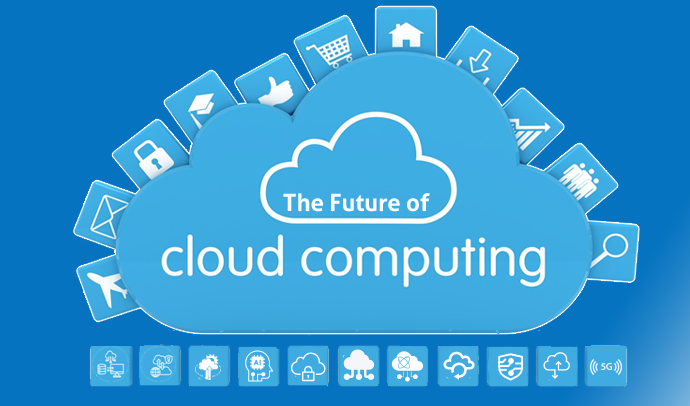Download PDF
The Future of Cloud Computing: Trends to Watch Out For
Introduction
Cloud computing has transformed the way organizations operate, offering unprecedented scalability, flexibility, and cost-efficiency. As technology continues to advance, the cloud computing landscape evolves with it. In this blog, we’ll explore some of the exciting trends and developments that are shaping the future of cloud computing.
1. Edge Computing
 Edge computing is poised to revolutionize cloud computing by bringing data processing closer to the source. Instead of relying solely on centralized data centers, edge computing leverages distributed infrastructure, such as IoT devices and edge servers, to process data locally. This reduces latency, enhances real- time processing, and supports applications like autonomous vehicles and smart cities.
Edge computing is poised to revolutionize cloud computing by bringing data processing closer to the source. Instead of relying solely on centralized data centers, edge computing leverages distributed infrastructure, such as IoT devices and edge servers, to process data locally. This reduces latency, enhances real- time processing, and supports applications like autonomous vehicles and smart cities.
2. Hybrid and Multi-Cloud Adoption
 Many organizations are embracing hybrid and multi-cloud strategies. Hybrid cloud combines on-premises infrastructure with public and private cloud services, offering flexibility and data sovereignty. Multi-cloud involves using multiple cloud providers for different workloads, reducing vendor lock-in and increasing redundancy.
Many organizations are embracing hybrid and multi-cloud strategies. Hybrid cloud combines on-premises infrastructure with public and private cloud services, offering flexibility and data sovereignty. Multi-cloud involves using multiple cloud providers for different workloads, reducing vendor lock-in and increasing redundancy.
3. Serverless Computing
 Serverless computing, epitomized by AWS Lambda, Azure Functions, and Google Cloud Functions, abstracts server management entirely. Developers can focus solely on code, and the cloud provider handles infrastructure provisioning and scaling. Serverless computing streamlines application development and reduces operational overhead.
Serverless computing, epitomized by AWS Lambda, Azure Functions, and Google Cloud Functions, abstracts server management entirely. Developers can focus solely on code, and the cloud provider handles infrastructure provisioning and scaling. Serverless computing streamlines application development and reduces operational overhead.
4. AI and Machine Learning Integration
 Cloud providers are integrating artificial intelligence (AI) and machine learning (ML) into their services, making it easier for organizations to build and deploy AI-driven applications. These services include AI/ML platforms, automated model training, and pre- built AI models for various use cases.
Cloud providers are integrating artificial intelligence (AI) and machine learning (ML) into their services, making it easier for organizations to build and deploy AI-driven applications. These services include AI/ML platforms, automated model training, and pre- built AI models for various use cases.
5. Quantum
Quantum computing represents a potential paradigm shift in computing power. While quantum cloud services are in their infancy, they hold immense promise for solving complex problems in fields like cryptography, logistics, and pharmaceuticals.
6. Cloud-Native Ecosystem
The cloud-native movement emphasizes building applications that are designed to run in cloud environments from the ground up. Containerization (e.g., Kubernetes) and microservices architectures enable rapid development, scaling, and resilience in the cloud.
7. Enhance Security Measures
 Security remains a top concern in the cloud. Cloud providers are continually enhancing security measures, including advanced encryption, identity and access management (IAM) solutions, and threat detection services to protect against evolving cyber threats.
Security remains a top concern in the cloud. Cloud providers are continually enhancing security measures, including advanced encryption, identity and access management (IAM) solutions, and threat detection services to protect against evolving cyber threats.
8. Green Cloud Computing
 Environmental sustainability is gaining prominence. Cloud providers are investing in green data centers and renewable energy sources to reduce their carbon footprint. Expect to see more emphasis on eco-friendly cloud solutions.
Environmental sustainability is gaining prominence. Cloud providers are investing in green data centers and renewable energy sources to reduce their carbon footprint. Expect to see more emphasis on eco-friendly cloud solutions.
9. 5G Integration
 The rollout of 5G networks is accelerating the adoption of cloud-based applications. Faster and more reliable connections enable real-time data processing, benefiting industries like healthcare, autonomous vehicles, and augmented reality.
The rollout of 5G networks is accelerating the adoption of cloud-based applications. Faster and more reliable connections enable real-time data processing, benefiting industries like healthcare, autonomous vehicles, and augmented reality.
Conclusion
The future of cloud computing is full of promise and innovation. These trends represent just a glimpse into the evolving cloud landscape, and they hold the potential to transform industries, improve efficiency, and drive technological advancements.
To stay ahead in this dynamic cloud environment and effectively leverage these trends, consider partnering with experts like Cloudopty. Cloudopty specializes in helping organizations optimize their cloud resources, reduce costs, and enhance their overall cloud management. They can assist you in navigating the exciting future of cloud computing.
